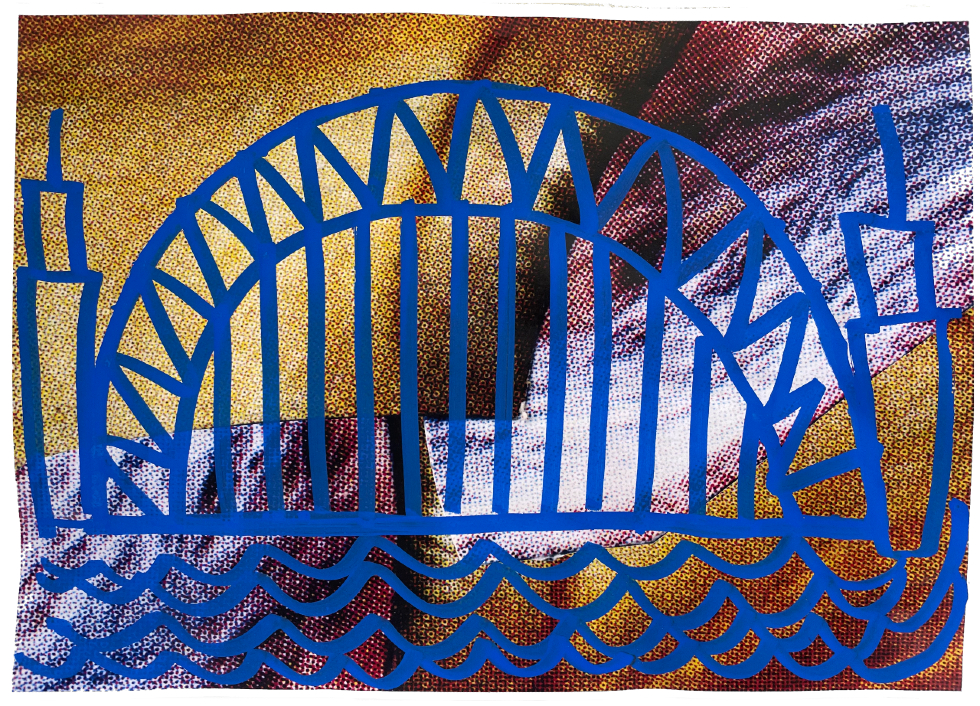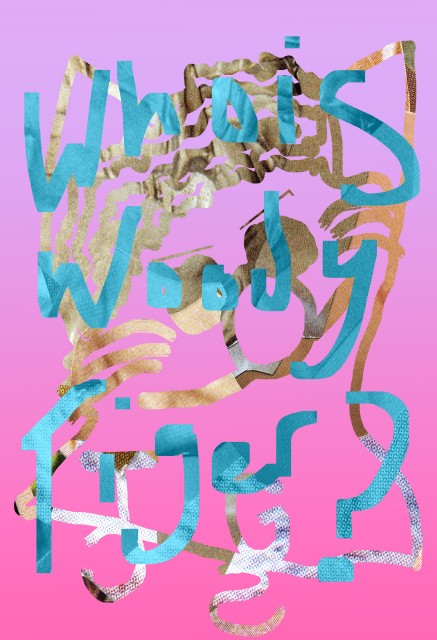Who is Woody Tiger?! Drawing Connections – An Interview with Cherelle Sappleton and Thom Roberts

How to conduct artist collaborations over different continents and during a lockdown? Linda Pittwood and Rachel Marsden report on Art et al’s “open ended digital residency” Peer/Peer, featuring artists Cherelle Sappleton and Thom Roberts…
“I’m having a look at what’s on everybody’s walls”, artist Cherelle Sappleton states in a few words what we have all been doing and thinking a million times in the last 18 months. To have a meeting now is an insight into another person’s home; to witness their artworks, created or otherwise acquired, furniture, houseplants, pets, and their… gongs?
Our encounter with Cherelle and discussion about her practice, takes place across a few different locations in the UK, but Sydney, Australia, is also present in the conversation. Lately, Cherelle has been working with artist Thom Roberts, who works from the supported studio, Studio A, Sydney. This collaboration is the second in the Peer/Peer series at Art et al., a new international digital platform elevating diverse voices, including showcasing curated work by neurodiverse artists from across the UK and Australia. Lisa Slominski, one of the three founding curators of Art et al. alongside Sim Luttin and Jennifer Gilbert, describes this bringing together of artists as “open ended digital residencies”.
The entry point to our conversation came from Cherelle and Thom’s collaboration saying something to us about care practices and cultural work, and the artist as individual and as network. In parallel to a Zoom chat with Cherelle, Thom responded to questions by email. Therefore, the interview, and even the writing process for this article, shares some resonance with the method of ‘exquisite corpse’, in itself intrinsic to the collaborative project.
Cherelle and Thom started the project by introducing their work via video. This evolved into digitally scanning and sending work back and forth, tracing and intervening in each other’s work; or as Thom put it, “I drew on them to make different feelings.” It was an opportunity to be inspired by each other; to question their existing practice and the parameters of concepts including ‘dialogue’, ‘exchange’ and ‘collaboration’.
In one of the initial videos exchanged by the artists, Thom shares a portrait of a female face. He gives the title, enigmatically, as “Woody Tiger”. This becomes a thread throughout his and Cherelle’s dialogue and a question later appearing as text in a piece of their collaborative work ‘Who is Woody Tiger?’ (2021). For Thom, names for people and things move fluidly and slip around – often calling Cherelle “Rach” – as images are flipped in the mirror and pictures turned into trains. He later reveals “Woody Tiger” is his name for Emma Johnston, principle artist at Studio A and his best friend, as she steps out from behind another artwork.

The complication of naming, of disciplinary boundaries, and the capacity of artworks to create and sustain connection can be found in Cherelle’s individual practice as well as her collaboration with Thom. She explains “I started out as a performer, interested in experimental theatre, in theatrical practitioners basing their aesthetic and method on the inherent knowledge of the body, rather than dreaming up emotion, using exercises to plumb what the body holds […] the archive of emotion and experience and that really has been a massive line within my practice.”
Cherelle continues to describe how her focus later shifted from performance to her own archive of magazine imagery, towards creating and mining other archives. “I started this project called ‘Scan/Exchange’ at Chisenhale Studios in late 2017. The basis of the first iteration of that project is that I staged an open call, asking for women based in Hackney and Tower Hamlets, women of colour, to come to the studio and bring images that were important to them. I would scan them at high resolution and give them the files and they could opt to donate one or several of the digital files to my collection so that I could start using and incorporating these personal family archival images.”
Working with other people’s imagery in her practice came with questions of authorship and consideration of ethics, we identified as providing a good foundation for working collaboratively across the world during a pandemic. Cherelle said of Scan/Exchange “I feel a huge sense of responsibility [when the participants share their images with me]. It informs the work, but exactly how I couldn’t tell you. It’s there and it’s an important part of the project, inviting the messiness and complexities of life, the consent and the responsibility – who is documented, who is seen.”
The outcome of Thom and Cherelle’s collaboration are works attributed to one of the artists when ‘in collaboration with’ the other. There is a responsibility to each other tangibly felt throughout the pieces and videos that led to their creation. There is also a sense of responsibility to the images themselves and the core ideas, which sit boldly in the outcomes. These are not over-worked collages; instead they are pieces with a graphic, formal confidence remaining true to both of the artists’ separate intentions and practices.
Drawing was a reoccurring topic in the conversation: a line, a series of coordinates, a motif. “What spoke to me was [Thom’s] drawing.” Reflecting on tracing his images using photoshop, Cherelle added: “I was like – yeah! – this is how I can invite drawing back into my practice. It doesn’t have to be in a sketchbook, although that might come later. It is interesting these realisations, what led me to a point when I thought drawing isn’t for me, or isn’t relevant to me? And [realising that] actually elements of drawing do happen in my practice, it’s just not with a pencil.” Thom remarked of drawing: “I brought my sense of fun and silliness to my drawings. I drew Kermit the Frog, the Harbour Fridge and Woody Tiger […] I got inspired by Rach’s drawings and I got a new idea.”
Drawing, connection to people and re-consideration of their own work and practice are some of the many positive outcomes of the project so far. Here, Cherelle points out reflecting again on the experience, one year from now may elicit a different answer. The other theme arising from our conversations is about the care practices art platforms and studios can embed in their cultural work with artists. “This project has been a joy,” Cherelle confirms, “[Art et al. has an] awareness that people work in a different way and sometimes aren’t comfortable making decisions or sending the first email.” The offer to help was an important part of the underpinning of the project. Cherelle also adds: “Language can do that in quite a light touch way.”
Although the exact nature of what is ‘collaboration’ and ‘exchange’ were never fully defined – perhaps they don’t need to be, rather embodied? – they can be words that lightly touched the artists, leaving them with the imprint of a supportive experience and a connection outlasting the parameters of the project. But what of the gong we can see behind her on the Zoom call? Cherelle explains although her work has long had an element relating to sound, sound baths and their capacity to generate visuals are new and yet to intersect with her existing practice. It seems to sum up the conversation thoughtfully, relating to her experiences with Thom alongside her individual practice, concluding with, “Lots of things are bubbling away.”
Linda Jean Pittwood and Rachel Marsden
Dr Linda Jean Pittwood is a cultural studies and contemporary art writer/researcher/teacher and currently Exhibitions Project Manager at Science and Industry Museum Manchester. Her broad interests come under the banner of interest in artistic knowledges, how art, in particular contemporary art, helps expand the ways in which we can understand the world. Recently this has included thinking about the body as art object in late capitalism, the role of art in science communication and the intersection of art, nature and care. She is working on her first monograph ‘Women and contemporary Chinese art’ contracted by Routledge.
Dr Rachel Marsden (she/her/hers) is a curator, educator and arts writer, researching transcultural curating and artistic practices in China and the Asia-Pacific. In addition, she is interested in care practices and ethics of care specific to social prescribing, inclusive pedagogies and disability justice based on lived experience. Alongside freelance curator and consultant roles, she is Associate Lecturer in Practice-based Research at UAL, Governing Board Member for China Residencies, and a member of the International Association of Arts Critics (AICA).
For more information: Peer/Peer, Thom Roberts X Cherelle Sappleton
Further Reading: Introducing Art et al
Images, from top: Thom Roberts in collaboration with Cherelle Sappleton, untitled, posca on scanned collage, 2021; Cherelle Sappleton in collaboration Thom Roberts, Who is Woody Tiger?, 2021





